Chicken Menudo or Menudong Manok was my Mama's clever way of making our weekday lunches special without breaking the bank. I can still remember coming home from school to the mouthwatering aroma of garlic and tomato sauce from our kitchen, knowing that this hearty, one-pot ulam was waiting for us.
While traditional menudo uses pork, my family prefers this chicken version - it's lighter, healthier, and honestly, just as flavorful! The tender chicken pieces, perfectly diced potatoes and carrots swimming in that rich, tomato-based sauce never fail to bring comfort, especially when served with steaming white rice.
Try it, this budget-friendly twist on the classic menudo might just become your family's new favorite recipe, too.
Jump to:
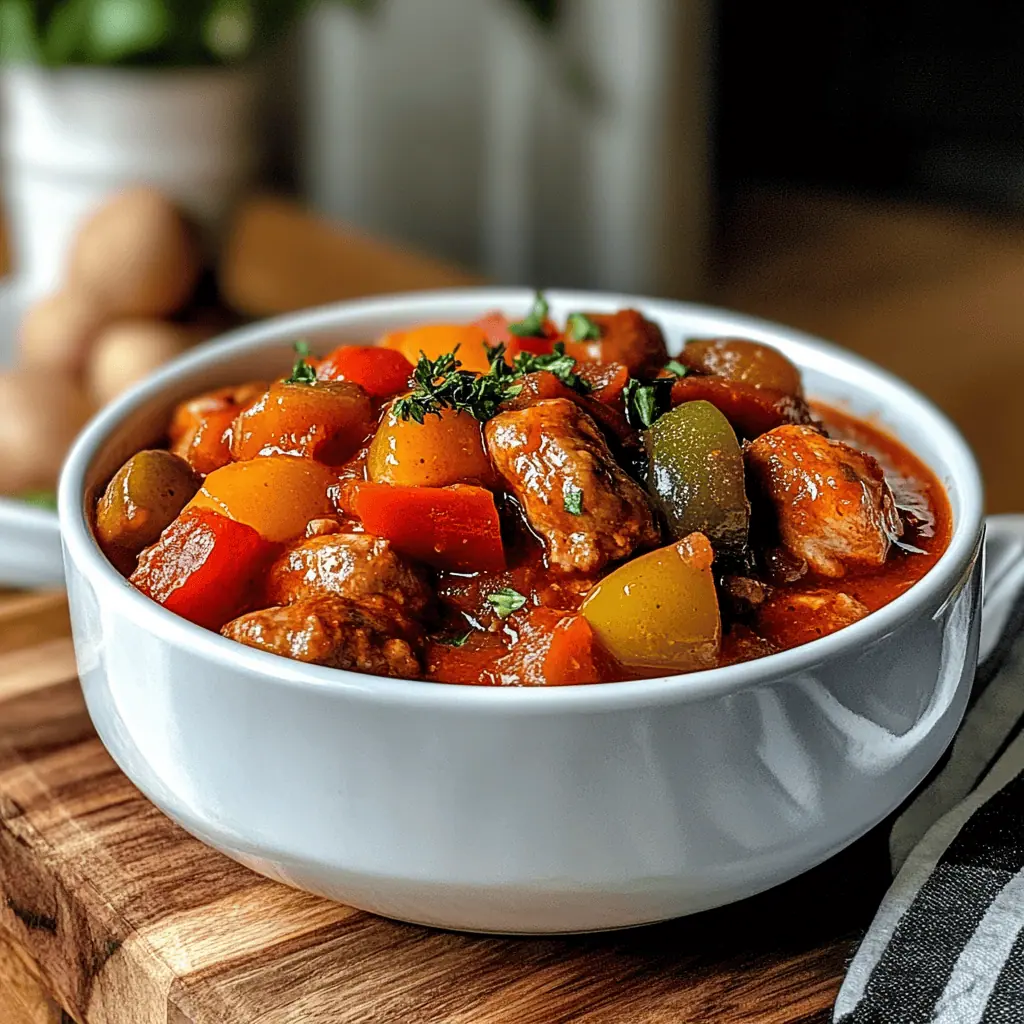
Why You'll Love This Recipe
- One-pot comfort food perfect for both everyday meals and special occasions
- Budget-friendly yet impressive enough for guests
- Customizable with various ingredients
- Makes plenty of leftovers that taste even better the next day
- Kid-friendly version of the traditional menudo
- Perfect balance of savory and subtle sweetness
Ingredients
These ingredients create the perfect harmony of flavors and textures in Filipino Chicken Menudo. Chicken thighs provide tender, juicy meat that holds up well to simmering, while Filipino hotdogs add a distinctive smoky-sweet element traditional to Filipino cooking.
The colorful vegetables offer different textures and nutrients, with raisins adding surprising bursts of sweetness. The sauce combines the acidity of tomatoes with the natural sweetness of pineapple juice, creating that signature tangy-sweet flavor profile that makes this dish so comforting and balanced.
Every ingredient has a purpose, from the potatoes that absorb the flavorful sauce to the bell peppers that add freshness and color.
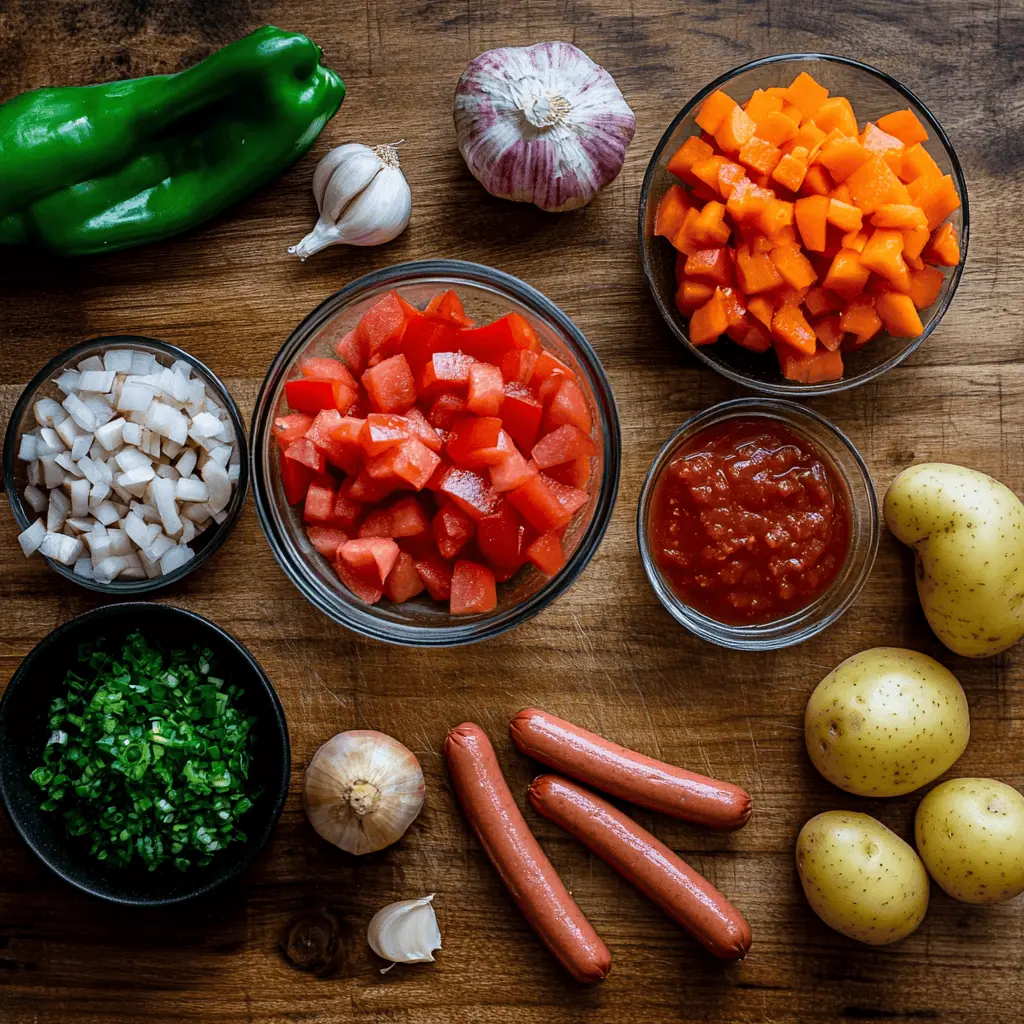
For the Main Protein:
- 3 pounds boneless skinless chicken thigh meat, cut into 1-inch cubes
- 4 Filipino-style hotdogs, sliced diagonally
- 2 tablespoons soy sauce
For the Vegetables:
- 2 large potatoes, peeled and cubed
- 2 large carrots, peeled and cubed
- 1 red bell pepper, cubed
- 1 green bell pepper, cubed
- 1 large onion, finely chopped
- 4 cloves garlic, minced
- 2 tablespoons raisins
For the Sauce:
- 1 can (14.5 oz) diced tomatoes
- ¼ cup tomato paste
- ½ cup pineapple juice
- 1 cup water
- 2 tablespoons cooking oil
- Salt and pepper to taste
Equipment
- Large heavy-bottom pot or kawali: For even heat distribution and preventing burning of the sauce
- Sharp knife: For precise cutting of ingredients to ensure uniform cooking
- Cutting board: For safe and clean ingredient preparation
- Measuring cups and spoons: For accurate measurements to maintain flavor balance
- Wooden spoon: For gentle stirring without scratching the pot's surface
- Can opener: For opening canned tomatoes and other ingredients
- Garlic press: Optional, for efficiently mincing garlic to release maximum flavor
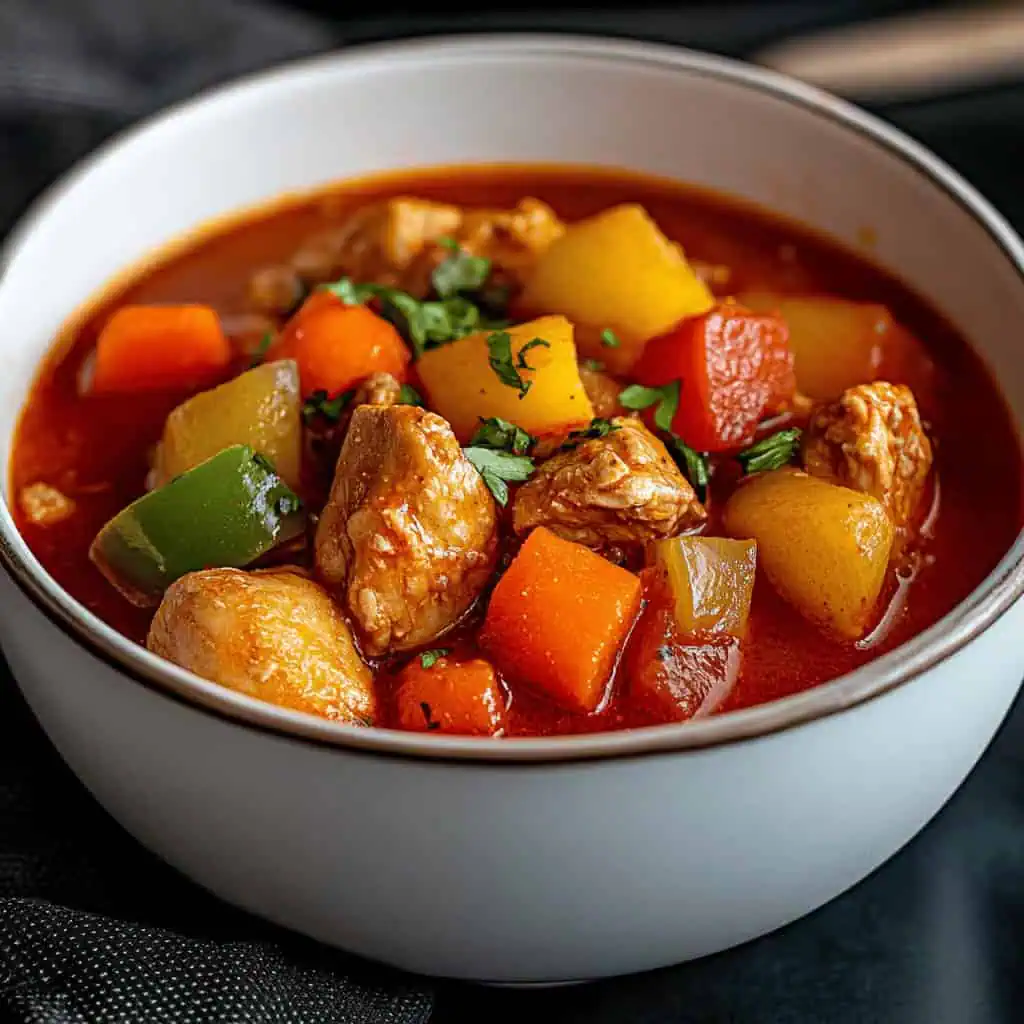
How To Make
- Begin by preparing all ingredients. Cut chicken thighs into 1-inch cubes, ensuring uniform size for even cooking. Cut potatoes and carrots into similar-sized cubes. Dice bell peppers, finely chop onions, mince garlic, and slice hotdogs diagonally.
- Heat 1 tablespoon oil in a large heavy-bottom pot over medium-high heat (350°F/175°C). Quickly sauté bell peppers for 30 seconds until tender-crisp, then remove and set aside. In the same pan, cook hotdogs until lightly browned (1-2 minutes), then remove.
- Add remaining oil and sauté garlic and onions until fragrant (2-3 minutes). Add chicken and cook until lightly browned (5-7 minutes). Add soy sauce and cook for another minute.
- Reduce heat to medium (325°F/165°C). Add pineapple juice and simmer for 2 minutes. Add diced tomatoes, tomato paste, and water. Bring to a boil, then reduce heat, cover, and simmer until chicken is tender (20-25 minutes).
- Add potatoes, carrots, and raisins. Cook until vegetables are tender (6-8 minutes). Return bell peppers and hotdogs to the pan and heat through (2-3 minutes). Season with salt and pepper to taste.
- Serve hot with steaming white rice. This dish tastes even better the next day as the flavors continue to develop.

Tips from Lola's Kitchen
- Meat Selection: Choose chicken thighs over breast meat for more flavor and tenderness. The higher fat content in thighs keeps the meat moist throughout cooking.
- Tenderizing Tip: Marinate chicken in pineapple juice for 30 minutes before cooking. The natural enzymes help break down the proteins, resulting in more tender meat.
- Color Enhancement: Add 2-3 drops of atsuete oil for a deeper red color that makes the dish more visually appealing.
- Flavor Boost: Add a bay leaf while simmering for extra aroma and depth of flavor. Remove before serving.
- Thickness Control: If sauce is too thick, add water gradually (¼ cup at a time); if too thin, simmer uncovered to reduce and concentrate flavors.
- Flavor Development: Prepare this dish a day ahead for even richer flavors as the ingredients have time to meld together.
Traditional Serving Suggestions
- Serve hot with steamed white rice
- Garnish with fresh cilantro for a pop of color and freshness
- Pair with calamansi on the side for a citrusy tang
- Serve with pickled papaya (atchara) for a contrasting sweet-sour element
- Excellent with crusty pandesal for breakfast the next day
Substitutions
- Protein Options: Chicken breast can replace thighs (reduce cooking time by 5 minutes)
- Sausage Alternatives: Vienna sausages or regular hotdogs can replace Filipino-style hotdogs
- Vegetable Swaps: Sweet peas can substitute for bell peppers if desired
- Protein Booster: Add quail eggs during the last 5 minutes of cooking for added protein
- Traditional Flavor: Add 2 tablespoons of liver spread for a more authentic menudo flavor
- Sweetener Options: Use pineapple chunks instead of juice, or substitute with a tablespoon of brown sugar
- Tomato Base: Fresh tomatoes (4-5 medium, diced) can replace canned if preferred
Troubleshooting
- Dry Chicken:
- Solution: Don't overcook the chicken; maintain proper heat and cooking time
- Add more sauce or a splash of chicken broth if the dish seems dry
- Use chicken thighs rather than breast meat for juicier results
- Watery Sauce:
- Solution: Simmer uncovered for 5-10 minutes to reduce excess liquid
- Add 1 tablespoon tomato paste to thicken the sauce
- Mix 1 teaspoon cornstarch with 1 tablespoon cold water and stir into the simmering dish
- Hard Vegetables:
- Solution: Cut into smaller, uniform pieces for faster cooking
- Add more cooking time (3-5 minutes) if vegetables are still firm
- Pre-cook stubborn vegetables separately if they're taking too long
- Bland Flavor:
- Solution: Add more salt and pepper gradually, tasting as you go
- Incorporate 1 chicken bouillon cube for deeper flavor
- A splash of fish sauce (patis) can add complexity and umami
Storage & Reheating
- Refrigeration:
- Store in an airtight container to prevent absorption of other food odors
- Keeps for 3-4 days in refrigerator
- Let cool completely before storing to prevent condensation and spoilage
- Date the container to track freshness
- Freezing:
- Freezes well for up to 2 months in freezer-safe containers
- Thaw overnight in refrigerator for best texture
- Freeze in portion-sized containers for convenient single servings
- Leave some space in containers as the dish will expand when frozen
- Reheating:
- Stovetop: Heat over medium heat until internal temperature reaches 165°F (74°C), stirring occasionally to prevent burning
- Microwave: Heat in 2-3 minute intervals, stirring between each to distribute heat evenly
- Add a tablespoon of water if the dish seems dry when reheating
- For best flavor, reheat gently to avoid overcooking the meat and vegetables
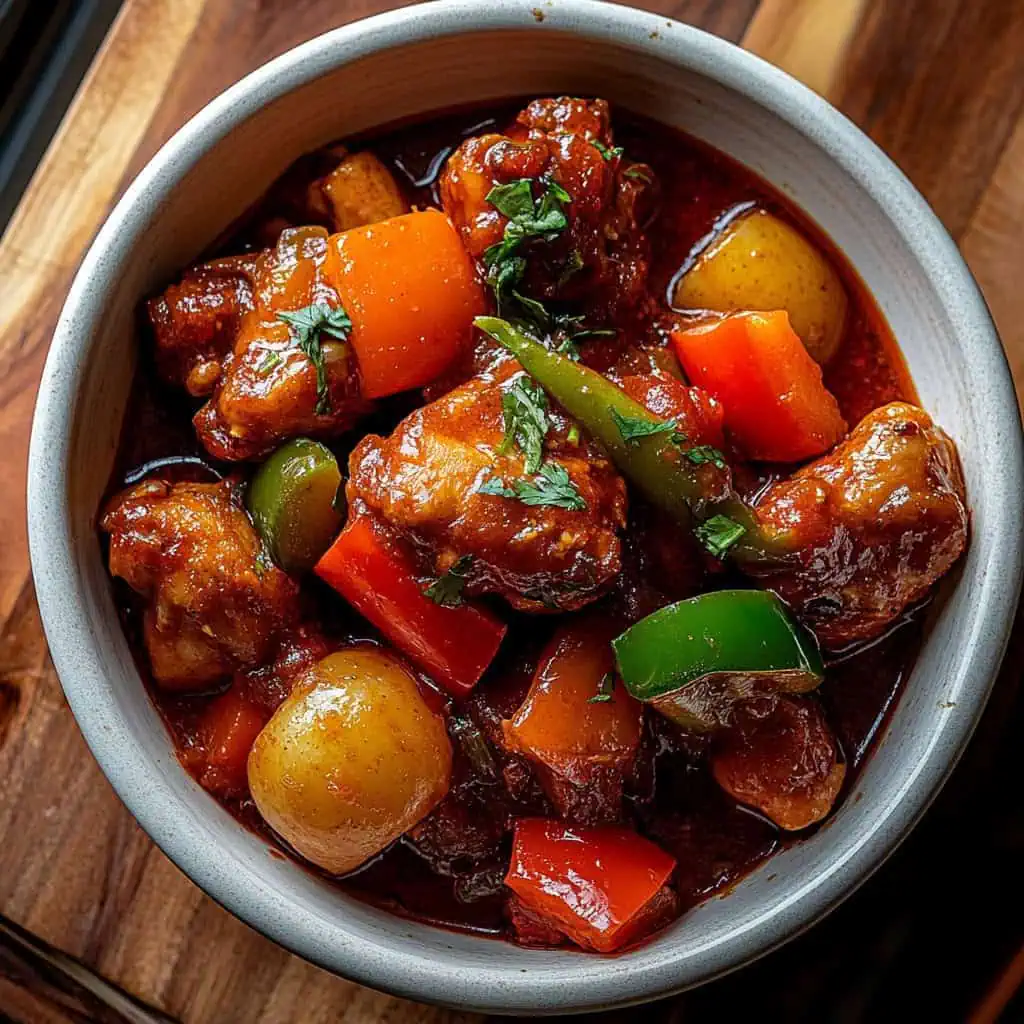
FAQ
Can I make this in advance for a party?
Yes! It actually tastes better the next day as flavors meld. Simply reheat thoroughly before serving.
How do I prevent the potatoes from getting mushy?
Add them at the right time and don't overcook. They should be fork-tender but still firm. Using waxy potatoes rather than starchy ones helps maintain their shape.
Can I use chicken breast instead of thighs?
Yes, but reduce cooking time by 5 minutes to prevent drying. You may also want to add a bit more oil or broth to keep the meat moist.
Is this recipe freezer-friendly?
Yes, it freezes well for up to 2 months in an airtight container. Thaw overnight in the refrigerator before reheating.
Can I make this spicy?
Yes, add chopped bird's eye chilies (siling labuyo) or red pepper flakes to taste. Start with a small amount and adjust according to your heat preference.
Can I cook this in a slow cooker?
Yes, brown the chicken and sauté the aromatics first, then transfer to a slow cooker with the remaining ingredients. Cook on low for 4-5 hours or high for 2-3 hours.
Is there a way to make this vegetarian?
Yes, substitute the chicken with firm tofu or tempeh, and use vegetable broth instead of chicken. Add the tofu during the last 10 minutes of cooking to prevent it from breaking apart.
What makes Filipino menudo different from Mexican menudo?
Filipino menudo is a tomato-based stew with meat and vegetables, while Mexican menudo is a soup made with tripe in a red chili pepper base. Despite sharing a name, they are entirely different dishes.
Related
Looking for other recipes like this? Try these:
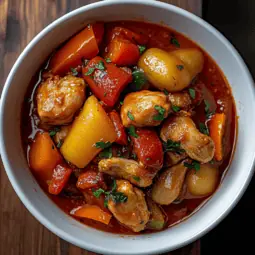
Filipino Chicken Menudo (Menudong Manok)
Equipment
- Large heavy-bottom pot or kawali (kawaling malalim) For even heat distribution and preventing burning
- Sharp knife (matulis na kutsilyo) For precise cutting of ingredients
- Cutting board (Sangkalan) For ingredient preparation
- Measuring cups and spoons (pangsukat na tasa at kutsara) For accurate measurements
- Wooden spoon (sandok na kahoy) For gentle stirring without scratching the pot
- Can opener (pambukas ng lata) For opening canned ingredients
- Garlic press (pangpisa ng bawang) Optional, for mincing garlic
Ingredients
For the Main Protein
- 3 pounds boneless skinless chicken thigh meat (manok), cut into 1-inch cubes
- 4 Filipino-style hotdogs sliced diagonally
- 2 tablespoons soy sauce toyo
For the Vegetables
- 2 large potatoes patatas, peeled and cubed
- 2 large carrots karot, peeled and cubed
- 1 red bell pepper pulang siling pangsigang, cubed
- 1 green bell pepper berdeng siling pangsigang, cubed
- 1 large onion sibuyas, finely chopped
- 4 cloves garlic bawang, minced
- 2 tablespoons raisins pasas
For the Sauce
- 1 can 14.5 oz diced tomatoes (tinimping kamatis)
- ¼ cup tomato paste
- ½ cup pineapple juice
- 1 cup water tubig
- 2 tablespoons cooking oil mantika
- Salt asin at paminta to taste
Instructions
- Begin by preparing all ingredients. Cut chicken thighs (manok) into 1-inch cubes, ensuring uniform size for even cooking. Cut potatoes (patatas) and carrots (karot) into similar-sized cubes. Dice bell peppers, finely chop onions (sibuyas), mince garlic (bawang), and slice hotdogs diagonally.
- Heat 1 tablespoon oil (mantika) in a large heavy-bottom pot over medium-high heat (350°F/175°C). Quickly sauté bell peppers for 30 seconds until tender-crisp, then remove and set aside. In the same pan, cook hotdogs until lightly browned (1-2 minutes), then remove.
- Add remaining oil and sauté garlic and onions until fragrant (2-3 minutes). Add chicken and cook until lightly browned (5-7 minutes). Add soy sauce (toyo) and cook for another minute.
- Reduce heat to medium (325°F/165°C). Add pineapple juice and simmer for 2 minutes. Add diced tomatoes (kamatis), tomato paste (pino na sarsa ng kamatis), and water (tubig). Bring to a boil, then reduce heat, cover, and simmer until chicken is tender (20-25 minutes).
- Add potatoes, carrots, and raisins (pasas). Cook until vegetables are tender (6-8 minutes). Return bell peppers and hotdogs to the pan and heat through (2-3 minutes). Season with salt (asin) and pepper (paminta) to taste.
- Serve hot with steaming white rice (kanin). This dish tastes even better the next day as the flavors continue to develop.
Tips from Lola's Kitchen
- Meat Selection: Choose chicken thighs over breast meat for more flavor and tenderness
- Tenderizing Tip: Marinate chicken in pineapple juice for 30 minutes before cooking
- Color Enhancement: Add 2-3 drops of atsuete oil for a deeper red color
- Flavor Boost: Add a bay leaf (dahon ng laurel) while simmering for extra aroma
- Thickness Control: If sauce is too thick, add water gradually; if too thin, simmer uncovered
Nutrition
The Story Behind Filipino Chicken Menudo (Menudong Manok)
Filipino Chicken Menudo, known locally as "Menudong Manok," stands as a testament to the Philippines' rich culinary heritage and its ability to transform global influences into uniquely Filipino flavors. While sharing its name with the Mexican tripe soup menudo, this beloved Filipino dish has evolved into something entirely different, showcasing the ingenious way Filipino cuisine adapts and reimagines foreign dishes.
During the Spanish colonial period (1521-1898), the original Mexican menudo made its way to Philippine shores through the Manila-Acapulco Galleon Trade. However, as with many adopted recipes, Filipino cooks began crafting their own version, adapting it to local tastes and available ingredients. The result was a hearty, tomato-based stew that became a cornerstone of Filipino family gatherings and celebrations.
Traditional pork menudo has long been a fixture at Filipino festivities, but the chicken variation emerged as families sought healthier, more economical alternatives. This adaptation reflects the practical ingenuity of Filipino home cooks, who often modify recipes to suit both nutritional preferences and budget constraints. The switch to chicken made the dish more accessible for everyday meals while retaining its beloved status as a special occasion favorite.
What makes Filipino Chicken Menudo truly special is its role in "pamana" or heritage cooking. Passed down through generations, each family's recipe carries subtle variations - a testament to the dish's versatility and the personal touches added by countless Filipina mothers and grandmothers. Some families swear by the addition of pineapple juice for sweetness, while others might include liver spread for added richness, creating a tapestry of flavors that tells the story of Filipino family cooking.
In modern Filipino households, Chicken Menudo has earned its place as a "lutong bahay" (home-cooked) champion. Its popularity spans breakfast tables, where it's served with pan de sal, to dinner parties where it takes center stage. The dish exemplifies the Filipino tradition of "authentic home cooking," where simple ingredients transform into something extraordinary through patient simmering and careful seasoning.
The evolution of Chicken Menudo also reflects changing times. While the traditional recipe remains beloved, contemporary versions might feature additional vegetables for added nutrition or substitute ingredients to accommodate dietary preferences. Yet, regardless of these modifications, the essence of the dish - its comforting, home-cooked character - remains unchanged.
For many Filipino-Americans and overseas Filipinos, Chicken Menudo serves as a taste of home, a dish that bridges geographical distances and connects them to their cultural roots. Its familiar aroma wafting through the kitchen can transport them back to their grandmother's cooking, making it more than just a meal - it's a vessel of memories and cultural identity.
Today, this beloved dish continues to grace Filipino tables worldwide, its rich tomato sauce and tender chicken pieces telling a story of culinary adaptation, family tradition, and the enduring comfort of home cooking. Whether served at a grand family celebration or as a simple weekday dinner, Chicken Menudo remains a shining example of Filipino cuisine's ability to transform the ordinary into the extraordinary.
As we continue to see a global rise in interest in Filipino cuisine, Chicken Menudo stands ready to introduce more people to the warmth and creativity of Filipino cooking. Its balance of flavors, nutritious ingredients, and heartwarming appeal make it a perfect ambassador for the rich tapestry of Filipino culinary culture.







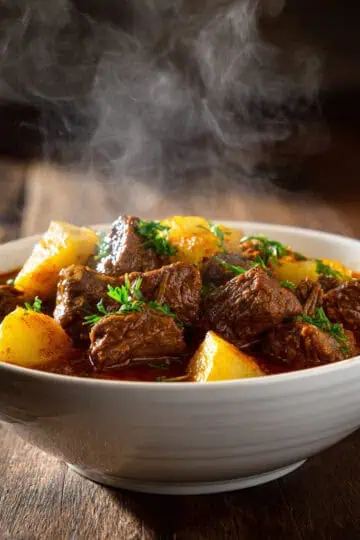
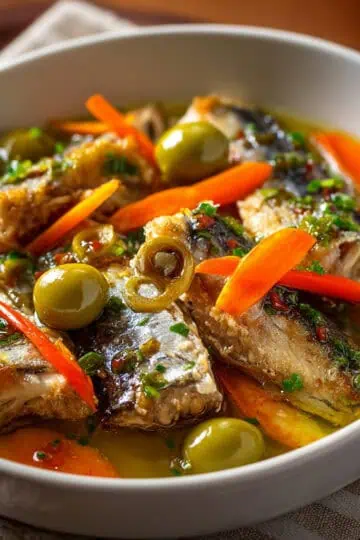
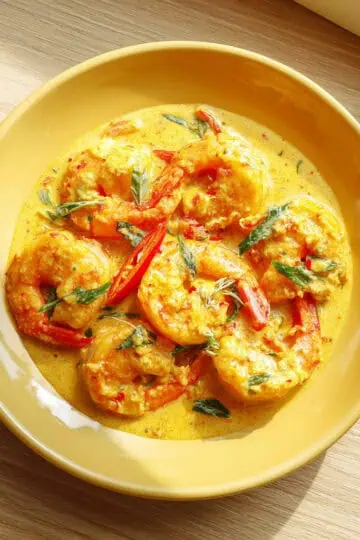
Comments
No Comments